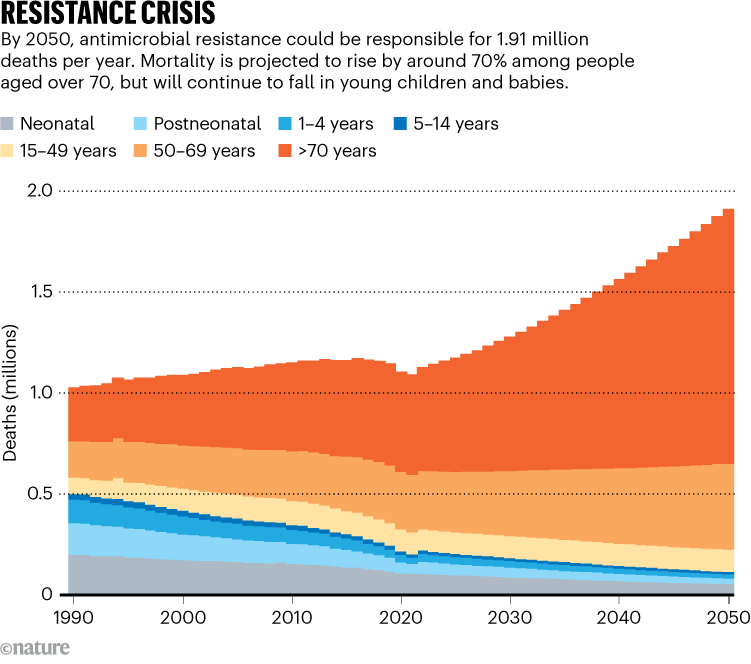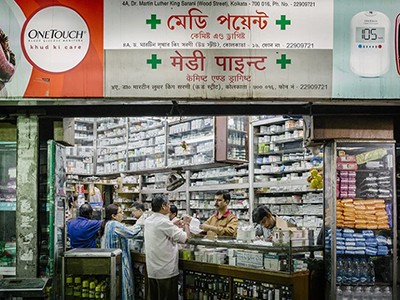
Acinetobacter baumannii — a bacterium associated with hospital-acquired infections that can develop resistance to antibiotics.Credit: Eye Of Science/Science Photo Library
More than 39 million people will die from antibiotic-resistant infections between now and 2050, according to an in-depth global analysis of antimicrobial resistance.
The report, published on 16 September in The Lancet1, found that between 1990 and 2021, more than one million people died from drug-resistant infections each year, and this could increase to nearly 2 million by 2050. Around 92 million lives could be saved between 2025 and 2050 with wider access to appropriate antibiotics and better treatment of infections, the report estimates.
The fight against antimicrobial resistance
“This is an important contribution for understanding how we’ve gotten where we are, and for giving a rational expectation of the future burden of [resistance] in order to inform next steps that can be undertaken,” says Joseph Lewnard, an epidemiologist at the University of California, Berkeley.
“I think the burden numbers are probably much higher than what has been reported here,” particularly in countries where there are data gaps, says Timothy Walsh, a microbiologist at the University of Oxford, UK. The figures suggest that the world is failing to meet the United Nation’s target of reducing mortality caused by antimicrobial resistance by 2030.
Growing death toll
Researchers analysed mortality data and hospital records from 204 countries between 1990 and 2021, focusing on 22 pathogens, 84 combinations of bacteria and drugs they are resistant to and 11 diseases, including blood infections and meningitis.
Their findings reveal that although the number of children aged under 5 dying from drug-resistant infections has fallen by more 50% over the past 3 decades, mortality rates in people aged over 70 have increased by 80% (see ‘Resistance crisis’).
Deaths from infections by Staphylococcus aureus — which infects skin, blood and internal organs — saw the biggest rise, increasing by 90.29%.

Source: Ref. 1
Many of the deadliest infections between 1990 and 2021 were caused by a group of bacteria with particularly strong drug resistance, called gram-negative bacteria. This category includes Escherichia coli and Acinetobacter baumannii — a pathogen associated with hospital-acquired infections.
Gram-negative bacteria are resistant to Carbapenem drugs, a class of antibiotics used to treat severe infections, and they can exchange antibiotic-resistance genes with different species as well as passing them to offspring. Deaths linked to Carbapenem-resistant gram-negative bacteria have risen by 149.51%, from 50,900 cases in 1990 to 127,000 cases in 2021.
The report estimates that, by 2050, antimicrobial resistance could cause 1.91 million deaths each year, and that a further 8.22 million people will die from illnesses associated with resistance. More than 65% of deaths attributed to AMR in 2050 will be among people aged over 70.
“This study shows we have a problem in health-system quality and prevention of infections,” says co-author Mohsen Naghavi, a physician and epidemiologist at the University of Washington in Seattle.
Targeted interventions
Regions with the highest predicted mortality rates include south Asia, Latin America and the Caribbean, and researchers emphasize that any strategies to tackle drug resistance must prioritize low- and middle-income countries.
Antibiotic resistance is a growing threat — is climate change making it worse?
“We need more global investment and a lot more real interactive engagement with low-income countries to make sure that they are equipped,” says Walsh. Strategies must ensure that hospitals in low-income countries have access to diagnostic tools, antibiotics, clean water and sanitation, he adds.
“Most of these deaths do not actually require new or boutique interventions to be prevented. That’s an important story that they tell,” says Lewnard.
Policymakers should also address the overuse of antibiotics in farming, which speeds up bacterial resistance, and invest in research for innovative antibiotic drugs, Walsh says.
The authors hope the report will “guide information on how to develop new drugs, which new drugs to focus on, what new vaccines to focus on”, says co-author Eve Wool, a research manager at the Institute for Health Metrics and Evaluation in Seattle, Washington.




